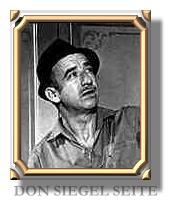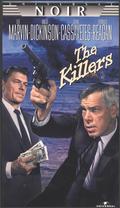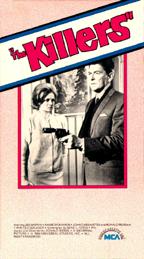 |
(The Killers)
|
 |
ANALYSE INFOS |
|---|
 |
(The Killers)
|
 |
ANALYSE INFOS |
|---|
| Zwei Killer, die im Auftrag einen Mann töten, gehen seiner Lebensgeschichte nach, um in den Besitz einer Million Dollar zu gelangen. |
| Lee Marvin
John Cassavetes Ronald W. Reagan Clu Gulager Claude Akins Norman Fell Virginia Christine Don Haggerty Scott Hale Peter Hobbs Ted Jacques Jimmy Joyce John Copage Tyler McVey Irvin Mosley Burt Mustin Kathleen O'Malley Robert Phillips Seymour Cassel Davis Roberts |
- Charlie
- Sheila Farr - Johnny North - Browning - Lee - Earl Sylvester - Mickey - Miss Watson - Postwagenfahrer - Hotel Clerk - Ausbilder - Gym Assistant - Verkäufer - Mann an der Tür - Steward - Postautowache - Älterer Mann - Empfangsdame - George - Desk Clerk - Maitre D' |
Don Siegel
Gene L. Coon Richard L. Rawlings John Williams Richard Belding Stuart H. Pappe Frank Arrigo George Chan George O'Connell Stanley Wilson Henry Mancini Don Raye Nancy Wilson John McCarthy James S. Redd Helen Colvig Bud Westmore
|
- Regie/Produzent
- Drehbuch - Kamera - Musik/Komponist - Schnitt - Schnitt - Art Director - Art Director - Art Director - Musikalische Leitung - Songwriter - Songwriter - Songwriter - Set Decoration/Design - Set Decoration/Design - Kostüme - Makeup |
"I wanted this brutal and sensual
film to have a substantial reality and a point of view. I wanted onte to
feel the intelligence, the coldness and the cynicism of the killers, that
their evil could be fascinating for the heroine, but for her alone, until
the moment when she is a victim of it. I didn't want my two killers, when
they went to see a group of people, to spend their time beating them up,
kicking them in the crutch or
 crushing
their faces with their heels. I preferred to show right from the pre-credit
sequence that they were capable of everything: from the first shots, one
sees them brutally beating a blind woman, then savagely battering down the
hero point blank. The thing is so shocking that from then on I didn't need
to make them do anything more. They are preceded all the time by their gestures,
they are dreaded. Their brutality is latent and the film, in fact, contains
few enough violent acts. crushing
their faces with their heels. I preferred to show right from the pre-credit
sequence that they were capable of everything: from the first shots, one
sees them brutally beating a blind woman, then savagely battering down the
hero point blank. The thing is so shocking that from then on I didn't need
to make them do anything more. They are preceded all the time by their gestures,
they are dreaded. Their brutality is latent and the film, in fact, contains
few enough violent acts.Angie Dickinson plays her role admirably, but the motivations of her character remain obscure. i accept the entire responsibility because I reworked the script a lot. I was conscious of this vague area in my work, but I wasn't able, if you like, to get away with it. Having concentrated on the killers, I unjustly emphasised the male protagonists. The Killers was made for television but not initially released to television. It was completed shorty after President Kennedy's assassination, and the studio thought it was too violent. I'm quite sure that in some way I was influenced by television, by the recognition that I had to be tight in on most things, that the long shots would have very little value. But I shot it as a feature. I shot it in the style which I feel is my style at its best, very taut and lean, with great economy. If I had to do it over, I don't think I would change much." (Lovell Interviews, S. 56/7) |
"'The
Killers', wie Siodmaks gleichnamiger Film nach der Kurzgeschichte von Ernest
Hemingway
 entstanden,
war zunächst als Fernsehfilm konzipiert, dann aber wegens einer
ausgeprägten Gewaltdarstellung in die Kinos geschickt worden. Diese
low-budget-Produktionen konnten zwar insgesamt Siegels Meisterschaft in der
Darstellung von action nicht ausschöpfen (die Fernsehdramaturgie erlaubt
gerade diejenigen Perspektiven und Einstellungen nicht, für die Siegels
action movies bekannt geworden sind), aber in einigen Szenen und vor allem
in der Führung der Schauspieler (Lee Marvin in einer seiner Gangster-Rollen)
knüpfte der Streifen doch an Siegels Gangsterfilme aus den fünziger
Jahren an. Es zeigte sich allerdings bei aller stilistischen Präzision
auch in seinen Filmen das Manko des Genres in diesen Jahren: Der Gangsterfilm
hatte keineThema, das geeignet gewesen wäre, insbesondere beim jungen
Publikum Betroffenheit auszulösen." entstanden,
war zunächst als Fernsehfilm konzipiert, dann aber wegens einer
ausgeprägten Gewaltdarstellung in die Kinos geschickt worden. Diese
low-budget-Produktionen konnten zwar insgesamt Siegels Meisterschaft in der
Darstellung von action nicht ausschöpfen (die Fernsehdramaturgie erlaubt
gerade diejenigen Perspektiven und Einstellungen nicht, für die Siegels
action movies bekannt geworden sind), aber in einigen Szenen und vor allem
in der Führung der Schauspieler (Lee Marvin in einer seiner Gangster-Rollen)
knüpfte der Streifen doch an Siegels Gangsterfilme aus den fünziger
Jahren an. Es zeigte sich allerdings bei aller stilistischen Präzision
auch in seinen Filmen das Manko des Genres in diesen Jahren: Der Gangsterfilm
hatte keineThema, das geeignet gewesen wäre, insbesondere beim jungen
Publikum Betroffenheit auszulösen."
Georg Seeßlen: Der Asphalt-Dschungel. Geschichte und Mythologie des Gangster-Films. Reinbek b.H. 1980. S. 196 |
| "The content of the movie is
unadulterated rupture. Think of how it cuts away from the assassination scene
to the wonderfully sleek and creepy shot of that rifle-case emerging from
a sedan door, the camera following the scurrying legs across a manicured
lawn, panning up to show Reagan anxiously looking over his shoulder (...)
If anything, Point Blank seems rather tame next to its predecessor:
its selfconsciously hip shock tactics are less extreme, less unthinkable,
than how the made-for-TV violence of The Killers casually exploded every
convention it embraced."
Howard Hampton: Return of the Body Snatchers. Don Siegel's The Killers. In: Film Comment 11/12 1996. |
| ---allmovie---imdb---lexikon des internationalen films--- |